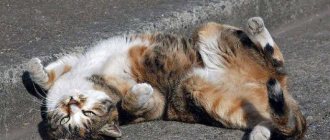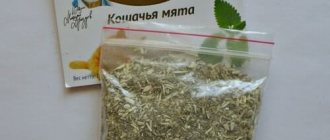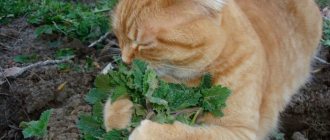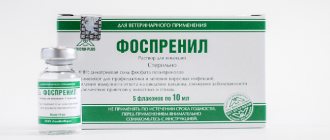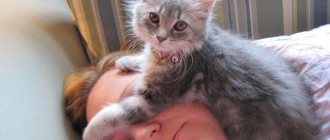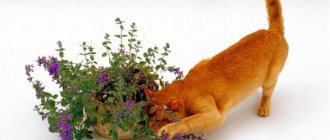Catnip is a low-growing plant that has a spicy aroma. This smell is very attractive to cats. The second name of the plant is lemon catnip or budra. Previously, in Egypt it was used as bait for cats, including their relatives such as panthers and leopards.
Despite the fact that the plant causes a strong emotional reaction in animals, it is absolutely harmless to them and is even used for medicinal purposes.
What is catnip
This is a perennial herb from the Lamiaceae family, the genus Catnip, the Latin name is Nepeta Cataria. What kind of plant is this, what does it look like? The stem of catnip grows up to 60-100 cm, the leaves are small, triangular in shape. The flowers are small and inconspicuous, white, with a purple tint, arranged in bunches at the top of the stem.
A characteristic feature of this herb is its high content of essential oil (3%), which causes a pronounced aroma. What does catnip smell like? For people, its smell is classic menthol with hints of lemon. The plant is native to the Mediterranean and North Africa and grows throughout most of Europe and North America. It is found mainly in forest clearings, wastelands and slopes. You can purchase dried and crushed leaves to a powder consistency at a pharmacy or pet store.
Content
1. About the beneficial properties of the plant 2. Catnip - what is it? 3. Can a cat have catnip 4. Is peppermint dangerous 5. How to use peppermint for cats 6. Peppermint as a means of education 7. For whom is mint dangerous?
Many pet owners know about cats’ strange love for the smell of mint, but few people think about whether cats can eat mint. It is interesting to observe how strangely pets behave when they smell the scent of weed. However, is it harmful to animal health?
How does catnip work on cats?
Catnip acts as a tranquilizer on cats. After eating it, the pet becomes playful, affectionate, shows increased activity, sometimes becomes overexcited, and bites. He purrs loudly, rubs against his legs, rolls on the floor, jumps or rushes around the rooms. Some individuals lick and gnaw at the source of the smell. Sometimes the plant has the opposite effect - the cat relaxes, looks at one point, and purrs sluggishly. The effect lasts no longer than 15-20 minutes.
However, catnip does not always have a noticeable effect on the behavior of the animal. Some cats remain indifferent to the scent of lemon balm. About 60-70% of individuals are sensitive to this herb - the rest are either indifferent to it or show little interest - no more than to any other plant with a strong odor.
How to use?
Dried herb or its tablet extract can be used for helminthiasis in pets.
For stomach pain and helminthiasis, the animal should be given 2-3 leaves of the plant to chew. However, lemon catnip will not be able to remove all parasites, so it should be used as part of general therapy. At the pet store you can purchase plant extract in tablets, which have a stronger effect. Veterinarians warn that the pet will die in the next 15-20 minutes. after consumption it may become overactive. If the cat has lost its appetite, then fresh leaves should be ground and added to food. Dried grass is also useful for cats, but it will give a weaker effect.
If your pet has a choleric character, then the mint aroma can provoke an outbreak of aggression due to overexcitement.
To relieve stress, for example, before a trip, moving house or visiting a doctor, you need to let your pet smell the leaves. Calmness will occur in 5-6 minutes. As an alternative, you can purchase or make your own cat toy stuffed with dried leaves. It is recommended to treat scratching posts with herbal extract, especially if the cat does not show interest in it, but damages the furniture.
Catnip: how to use it correctly
This herb is used as a mild natural sedative, an antidepressant for an animal that has suffered serious stress, or before an inevitable stressful situation: a trip to the veterinarian, a long trip, etc. Beneficial properties of catnip: the essential oil helps the pet calm down, relaxes, improves digestion, and in small quantities relieves nervous excitement.
The described drug is sold in powder or liquid form (essential oil concentrate). How to use dry catnip? A bag of powder is placed inside the bed to accustom the cat to it, or the animal is allowed to play - during entertainment, he will inhale the smell, which has a milder effect on the psyche than ingestion.
A spray with a concentrate is used to spray a scratching post, toys, or tray brought from the store to attract the pet’s attention. An adult cat is given no more than 4-5 drops of liquid medicine dissolved in a bowl of water - undiluted concentrate irritates the gastrointestinal tract, provokes disorder and inflammation of the delicate mucous membrane. The permissible norm of fresh leaves is 2-3 at a time. The recommended interval between mint use is 4-5 days.
How to grow catnip in a pot - step by step instructions
In nature, catnip can be found in forests, bushes, meadows, fields, vegetable gardens, along river banks and near roads. To be able to pamper your pet at home, you can grow the plant indoors in a pot. Please note that catnip loves warmth, moisture and light. A lack of these components can negatively affect the performance of the plant.
Catnip can be grown from seeds, which are sold at any pet store. But it’s better to take a cutting or a rooted shoot, which can be found right on the street. The cutting should be placed in a glass of water, where it should remain until roots appear. When choosing a pot, you need to give preference to a medium-sized container.
The plant is recommended to be planted in early autumn. Then you should follow the following sequence of actions:
- Pour drainage into the pot.
- Fill the container halfway with soil, which should be pre-moistened.
- Plant seeds or seedlings in the ground.
- Cover the pot with film, creating greenhouse conditions.
- Place the container in a lighted place.
After two weeks, sprouts should appear. When the first leaves form, the plant should be fed. It is necessary to select the strongest shoots and clear space for their growth. The stems need to be secured with wire. About 2.5 months after planting, with proper care, catnip should bloom.
Attention! The pot with the plant must be placed in a place inaccessible to the cat. Otherwise, the animal will damage the sprouts and the catnip will die.
Catnip should be re-fertilized in February, when daylight hours increase and the plant begins to actively grow. It is necessary to ensure that the catnip has enough light. Otherwise, the amount of essential oils in the leaves will decrease.
In summer, catnip should not be kept in direct sunlight to prevent the soil from drying out. The plant loves moisture, so there should always be water in the pan.
Why cats love catnip
Animals love catnip because of the nepetalactone it contains. This substance is similar in effect to the pheromone released with the onset of sexual heat. The plant itself is protected from attacks by parasites such as aphids. Mint can evoke different emotions in an animal: from aggression to euphoria. The first is more common in usually phlegmatic, imperturbable individuals.
After eating the grass, the pet demonstrates arousal similar to sexual stimulation. The calm ones become energetic, even violent; hyperactive ones, on the contrary, are affectionate and calm. In addition to the psychotropic effect, the smell of the plant repels blood-sucking insects, which is why cats love to wallow in mint thickets and rub their faces on the leaves and flowers.
About the beneficial properties of the plant
More than 25 species of plants from the Lamiaceae family are called mint. The main difference is the characteristic aroma, which provides a high menthol content in the plant.
People have long known about the beneficial properties of the plant and have been using the plant in medicine, cooking and other areas of life since ancient times. In Ancient Greece, mint was used to make refreshing perfumes, and in Ancient Rome it was used as a good breath freshener.
The beneficial properties of mint are due to the composition of the plant. It contains tannins and flavonoids, phytoncides, vitamins - including provitamin A (carotene) and ascorbic acid (vitamin C), essential oils, microelements necessary for a living organism - calcium, potassium, iron, magnesium. Peppermint is used in traditional and folk medicine. It is used as an analgesic, vasodilator, tonic and sedative. In addition, the plant has disinfectant, choleretic properties, and has a positive effect on the functions of the gastrointestinal tract.
Mint is included in various medications - ointments, tinctures, tablets. Medicines are used in the treatment of many diseases - headaches, insomnia, upper respiratory tract diseases, nervous pathologies, etc.
Is catnip harmful to cats?
Unlike valerian, catnip is not a drug for cats. It does not cause addiction or “hangover”, its effect on the psyche is much gentler and safer. Veterinarians do not name direct indications for the use of the product, leaving it at the discretion of the owner. According to veterinarians, mint cannot be called harmful if you follow the permissible dosage and limit yourself to a few drops and aromatic bags. The only direct contraindication concerns pregnant women - the medicine increases blood flow. Use caution when giving the product to particularly excitable animals - it can produce an unpredictable effect on individuals with a sharp temperament.
Is peppermint dangerous?
Peppermint most often grows in summer cottages and gardens. It does not cause such euphoria as catnip in pets, but cats themselves choose which herbs they need for health. Therefore, it is not worth forbidding the cat to eat mint, driving the cat away and brutally weeding the entire area. Peppermint contains many vitamins and microelements necessary for animals. If a cat chews a mint leaf, it means he needs it.
Peppermint is added to cat toys and treats, and some manufacturers even add it to complete food. It normalizes the functioning of the gastrointestinal tract, eliminates flatulence, normalizes bile secretion functions, and stimulates cardiac activity.
Catnip for kittens
Unlike sexually mature individuals, kittens are practically indifferent to the smell and taste of catnip. For pets under 8-9 months of age, this plant is of no interest. The fact is that the immature organism is not yet familiar with the sex pheromone, the smell of which is imitated by essential oils of mint, does not distinguish and does not react to it. At the same time, catnip is absolutely harmless, even useful for the growing kitten’s body. 2-3 drops are added to the drink monthly - the product improves digestion, contains antihelminthic microelements, and improves sleep.
Is it harmful to cats?
To teach your cat commands, you can use catnip leaves as a reward treat. Training takes place 2-3 times faster.
Having eaten too much grass, the animal will begin to roll on the ground.
Excessive consumption of the plant can cause the animal to meow loudly, convulsively move its paws, jump in place and roll on the ground. The Peppermint Cat often also hallucinates and experiences a feeling of euphoria. However, according to veterinarians, the symptoms do not pose a threat to the life and health of the animal. Veterinarians prohibit giving mint to pregnant cats, since excessive stimulation can have negative consequences for babies in the womb. There is a risk of premature birth. Mint is also harmful for cats, which react very sharply to odorous aroma - an outburst of emotions will deplete the central nervous system. With frequent use, sensitive pets will develop neurosis. The plant will not harm kittens and cats, but if the pet does not like catnip, then it should not be forcibly introduced into the diet.
Description of the plant
Lemon catnip in the wild.
Lemon catnip grows actively in a number of regions:
- Central, Eastern and Western parts of Europe;
- Eastern part of Asia;
- western part of Siberia;
- Caucasus.
In appearance it is similar to the most common peppermint. The chemical composition of these plants is slightly different. Peppermint is rich in menthol. Catnip contains the substance nepetalactone in its stems and leaves. It is thanks to nepetalactone that the aroma of catnip contains subtle lemon tones.
Catnip leaves are light green and heart-shaped. Sometimes they may have white and pink spots on them. During flowering, small tassel-shaped flowers appear, located on long stems.
They spread low on the ground and twist together, quickly turning into dense bushes. In total there are more than 200 species of this plant. Cats and cats love to spend their time in these thickets. Catnip lures these animals with its aroma, similar to the smell that valerian emits. Many furry pets behave very strangely when meeting this plant, and sometimes even inappropriately.
Why such a passion for inconspicuous weed?
Catnip contains an essential oil whose main ingredient is nepetalactone . This is what has a powerful appeal to many cats. For many, but not for all.
Approximately 70% of cats react to catnip, but the remaining 30% are indifferent to it. That is, every third cat is not susceptible to this plant. Why?!
A special gene is responsible for sensitivity to nepetalactone, and not all cats have it. Thus, the addiction to catnip is genetic.
Interestingly, the effect of the grass on a cat lasts 5-10 minutes and appears again no earlier than an hour later.
Why do cats need mint?
Catnip is needed primarily for cats to relieve anxiety. It can also serve as an excellent training tool.
Using herb or spray you can achieve the following:
- Get used to the scratching post. You can attach the mint to the dog yourself, which will significantly increase the cat’s interest. Many manufacturers sell scratching posts already with catnip under the upholstery.
- “Make” the carrier not so “dangerous” for the cat. And a new sleeping place or bed is more attractive.
- Enrich your cat's leisure time if you buy toys with catnip or make them yourself. This is especially valuable if the animal is overweight or remains at home without its owner for a long time. Mice with mint will increase your pet's activity and help realize the natural instincts of a hunter.
- Help you relax in stressful situations (moving to a new house, traveling by car, visiting the veterinarian), socialize when sharing with other animals.
What are the benefits of mint for pets?
In any case, the plant not only has a negative effect on cats, but also has its advantages when consumed and smelled. Many cat lovers use mint to correct cat behavior . An active, sometimes elusive, occasionally aggressive cat will be calmed by a short session of mint sniffing. Behavior changes, characterized by complaisance and calmness. But for a calm animal with sluggish physical habits, the plant plays the role of a pathogen. Being in a space with the scent of mint, the cat activates its behavior, becomes playful and active.
The effects of catnip on a cat
Surprisingly, the effect of catnip on an animal can vary greatly depending on how the cat “took” it. So, if the sense of smell comes into play (for example, a cat sniffed a toy to which catnip was added), after a while the situation will resemble estrus: the animal rubs its head and body on the grass and floor, jumps, rolls, makes calling sounds and purrs. However, the strong effect of excitement will stop after 10–15 minutes. After this, you will have to wait at least another half hour before the cat again shows interest in the toy.
When eaten, catnip produces the opposite effect: it has a mild calming effect..
It’s not just our pets that can react to catnip. “Big cats”: tigers, leopards, jaguars, lions - also cannot resist him.
Not all cats react the same way to catnip. Sensitivity to it is inherited, and if a particular individual has not received the corresponding gene, it will be indifferent to the smell, which is so tempting for its other comrades. It is also worth noting that kittens up to 3–6 months old (before the age of puberty) are not attracted to it at all, and are even repelled by it. About a third of all mustachioed tabbys are, in principle, indifferent to the smell of catnip and do not pay attention to it either in toys or on a walk.

